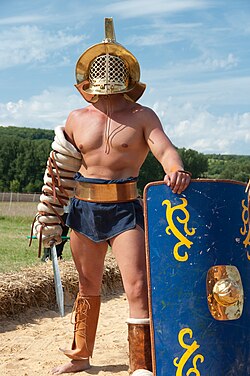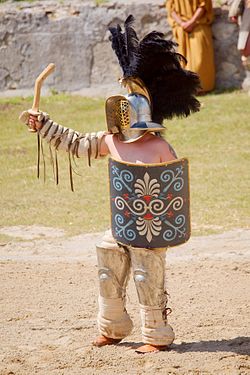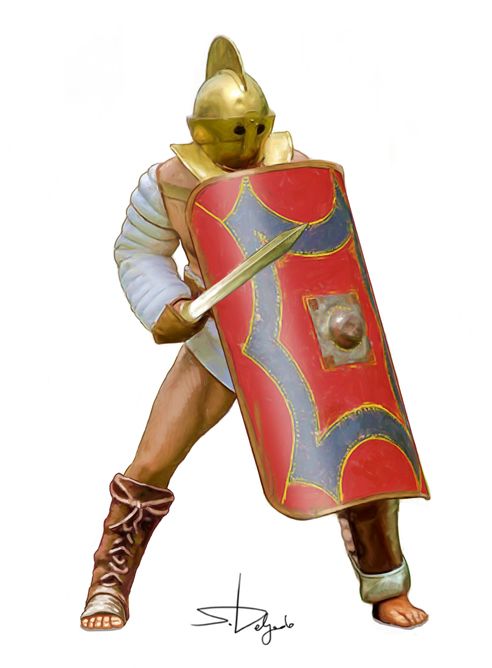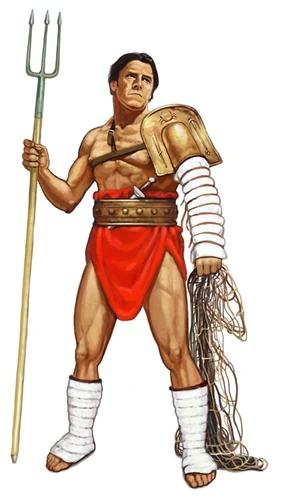Gladiator classes in ancient Rome developed over time, with each class reflecting different cultures and fighting techniques. These gladiators were matched against each other to create exciting and strategic battles for the crowd. Each class had its own unique weapons, armor, and skills, making every contest a test of strength, speed, and tactics.
Some gladiators fought with heavy protection and relied on power, while others focused on agility and precise attacks. Their equipment and combat styles often came from the regions Rome had conquered, which added variety to the games and kept the Roman audience interested.
Key Takeaways
- Gladiator classes evolved from different cultural backgrounds and fighting styles.
- Each class had distinct armor, weapons, and tactics suited for specific matchups.
- Their battles combined Roman ideals with the traditions of conquered peoples.
Early Development of Gladiator Types
Changes from Gaul and Thracian Roots
Gladiator classes did not appear overnight. Many categories evolved from warriors of regions like Gaul and Thrace. For example, one type began as the Gauls, named after the people Rome once fought. When Gauls became part of the Roman world, their image in the arena changed. Instead of looking like outsiders, these gladiators were given new roles and looks, better matching Roman values.
The Thracian-based class also took pieces from Thracian warriors. They kept special items such as the curved sword, which was a key feature of real Thracian fighters. These weapons and fighting styles helped make the matches exciting, especially when paired against heavily-armored opponents.
| Gladiator Origin | Original Influence | Signature Weapon | Armor Style |
|---|---|---|---|
| Gallish-Type | Gaul Warriors | Gladius (short sword) | Heavy, full helmet |
| Thracian-Type | Thracian Warriors | Curved sword (sica) | Medium, tall helmet |
Roman Identity and Meanings
Over time, the Roman state shaped these classes to reflect its own beliefs and power. The names and gear of each gladiator type took on new meanings. For example, one class got its name from the Greek word for “fish,” highlighting the shape of its helmet. This detail showed how the Romans loved to mix cultural symbols.
The gear for many gladiator types was made to look like Roman soldiers. Large shields and heavy armor helped show that these fighters stood for discipline and military power. The design choices were not just for looks; they also honored Roman traditions and made sure the fights matched what the audience expected.
- Heavy armor and shields: Signaled strength and Roman order.
- Animal and myth symbols: Added extra meaning and entertainment.
- Pairings: Clashes between classes (for example, fast vs. strong) told a story of Roman ideals.
These changes shaped how people saw each gladiator, turning old enemies into symbols of Rome itself.
Murmillo Gladiator Overview
Origins and Historical Roots

The Murmillo class arose as Roman society shifted its view on earlier gladiators, especially those modeled after Gallic warriors. As the Gallic people became more accepted in Rome, a new gladiator type was introduced. The name “Murmillo” comes from the Greek word for fish, referencing the fish-shaped crest on their helmets. Murmillos represented the Roman ideal of a disciplined, heavily armed soldier, and their look and fighting style mirrored those of the Roman military.
Weapons and Protective Gear
Murmillo gladiators were known for their heavy equipment, which required them to be physically strong. They wore:
- Helmet: A large bronze helmet with a high crest shaped like a fish fin
- Shield: The scutum, a big rectangular shield like those of Roman soldiers
- Armguard: A manica worn on the sword arm
- Leg Guard: A single bronze greave on the left leg
- Sword: The gladius, used for short-range combat
This gear gave the Murmillo excellent protection, but limited their speed and mobility compared to other fighters.
Combat Style and Reputation
Murmillos fought with a focus on steady, disciplined attacks similar to Roman legionaries. They used their armor and large shield to stay safe while pressing forward and wearing down the opponent. Their style was less flashy but showed off their endurance and skill. Because of their connection to the Roman army, crowds saw them as brave and tough, often admiring their strength and determination.
Typical Matchups in the Arena
Murmillo gladiators were commonly paired against opponents with different abilities. Their most frequent matchups included:
| Opponent Type | Key Characteristics |
|---|---|
| Thraex (Thracian) | Agile, quick with a curved sword and smaller shield |
| Retiarius | Lightly armored, used a net and trident |
| Hoplomachus | Inspired by Greek hoplites with spear and round shield |
These matchups highlighted the Murmillo’s heavy defense against faster or more lightly armed rivals, making for memorable and popular duels.
Thraex Warrior Type
Roots and Cultural Shaping

The Thraex class took inspiration from warriors living in Thrace, a region that includes parts of today’s Bulgaria, Greece, and Turkey. As Rome took control over Thrace, some of these warriors ended up fighting in the arenas. Their fighting style and weapons became part of the Thraex class, keeping important parts of their culture and battle ways.
Gear and Special Traits
The Thraex wore a helmet with a high crest, often decorated with a griffin or another myth creature, which pointed back to their heritage. Their armor included:
- A short, curved sword called a sica
- A small, round or rectangular shield called a parmula
- Two tall metal greaves for leg protection
- A padded or metal armguard, or manica
This setup made them lighter and more mobile than heavier fighters, but still offered some defense.
Fighting Style and Advantages
They were fast, using quick moves to strike where enemies were weakest, often aiming for unguarded areas like the back or legs. The Thraex used their curved sword to slip past shields and hit hard-to-reach spots. Their medium-weight armor helped them move easily while still staying protected.
Usual Arena Opponents
The Thraex most commonly faced the Murmillo, a matchup made popular because the Murmillo fought with heavy armor and big shields, which challenged the speed and skill of the Thraex. They also sometimes fought against classes like the Hoplomachus and the Secutor. These matchups kept the fights interesting and showed off the Thraex’s unique strengths.
Secutor Gladiator Overview

How the Secutor Was Developed and Changed
The Secutor, which means “chaser” in Latin, was created to fight a specific opponent in the Roman arena—the Retiarius. The design and gear of the Secutor were based on the Murmillo class, but with updates that helped them face fast, lightly-armored gladiators. The biggest change was to the helmet, making it smooth and rounded with few decorations. This made it less likely to get caught by the net of the Retiarius. Over time, the Secutor was seen as a regular and important fighter in the games, especially during the peak of the Roman Empire.
Weapons and Protective Equipment
The Secutor carried:
- Large Scutum Shield: Protected most of the body.
- Gladius: A short sword for close attacks.
- Manica: A metal arm guard worn on the sword arm.
- One or Two Leg Guards: Protected the lower legs and shins.
- Special Helmet: Smooth, round, with small eye holes for defense against the Retiarius’ net and trident.
| Equipment | Description |
|---|---|
| Helmet | Rounded, few decorations, narrow eye slits |
| Shield (Scutum) | Large, rectangle shield covering the body |
| Sword (Gladius) | Short, made for thrusting in close combat |
| Manica | Arm guard for sword arm |
| Leg Guards | Worn on one or both legs for extra protection |
The helmet offered good protection but made breathing hard and reduced vision.
Tactics Used to Counter Opponents
Secutors needed a plan that was all about closing in quickly. Since the Retiarius used a net and trident to keep away, the Secutor tried to chase fast and block attacks with their shield. They pushed forward to avoid getting tangled in the net and to stop the Retiarius from using their advantage at longer range. Once close, the Secutor would use strong thrusts with the gladius and cover themselves with the shield. Good defense and steady movement were key for success.
Tactics included:
- Using the shield to block trident attacks
- Moving quickly to avoid the net
- Striking with the gladius once close
- Keeping a steady, forceful approach to tire out the opponent
Place of the Secutor in Roman Arena Fights
The Secutor became very popular in the arena, especially against the Retiarius. Their matches were well-loved by the crowd because each type had opposite strengths and weaknesses. Secutors often represented the organized, strong Roman soldier and faced opponents who relied on speed and tricks. These classic battles were highlights at the games, making the Secutor one of the main gladiator classes until the end of the gladiatorial tradition in the fourth century CE.
Retiarius Gladiator Group
Distinct Features and Origins

The retiarius stood out from other gladiators because of his fisherman-inspired style. Instead of swords and heavy armor, the retiarius fought using tools similar to what a fisherman would use. He wore minimal armor and was recognized by his net and trident, reflecting this unique background.
Simple Gear and Primary Weapons
The retiarius wore only a few pieces of protective gear. He used a manica (an armored sleeve) and a special metal shoulder guard, both worn on his dominant arm. For weapons, he carried:
- A long trident (usually 1.6–2 meters)
- A weighted net for trapping opponents
- A small dagger, called a pugio, for close combat
This equipment made the retiarius quicker and lighter than his rivals.
Movement and Fighting Strategies
The retiarius was famous for avoiding direct hits. Instead of standing still and blocking attacks, he used speed and quick movements. His main tactic was to keep his distance using the trident, and wait for a chance to trap his opponent in the net.
When his enemy was caught or off balance, the retiarius would attack fast, using the trident or, if necessary, his dagger. This style focused on staying away from danger and wearing out heavy-armored foes.
Memorable Battles in the Arena
Fights with the retiarius were popular because of the clear difference in fighting styles. The retiarius was often matched against heavily armored gladiators, such as the secutor. This created exciting contests—one gladiator moved quickly and tried to trap, while the other relied on armor and strength.
These fights looked dramatic to the crowd, with the retiarius dodging, circling, and looking for openings. The visual of a net and trident against heavy shields and swords became a memorable part of Roman arena games.
